The Real-Time Monitoring of the Laser-Induced Functionalization of Transparent Conductive Oxide Films
Abstract
:1. Introduction
2. Materials and Methods
3. Results and Discussion
3.1. Electrical Monitoring System: Contact Method
3.1.1. ITO/Quartz Glass
3.1.2. ICO:H/PET Films
3.2. Optical Monitoring System: Non-Contact Method
3.2.1. Single-Point Measurement System
3.2.2. UV/NIR Camera System
4. Conclusions
Supplementary Materials
Author Contributions
Funding
Data Availability Statement
Conflicts of Interest
References
- Granqvist, C.G.; Hultåker, A. Transparent and conducting ITO films: New developments and applications. Thin Solid Film. 2002, 411, 1–5. [Google Scholar] [CrossRef]
- Porch, A.; Morgan, D.V.; Perks, R.M.; Jones, M.O.; Edwards, P.P. Electromagnetic absorption in transparent conducting films. J. Appl. Phys. 2004, 95, 4734–4737. [Google Scholar] [CrossRef]
- Calnan, S.; Tiwari, A.N. High mobility transparent conducting oxides for thin film solar cells. Thin Solid Film. 2010, 518, 1839–1849. [Google Scholar] [CrossRef]
- Klein, A. Transparent conducting oxides: Electronic structure–property relationship from photoelectron spectroscopy with in situ sample preparation. J. Am. Ceram. Soc. 2013, 96, 331–345. [Google Scholar] [CrossRef]
- Koida, T.; Fujiwara, H.; Kondo, M. Reduction of optical loss in hydrogenated amorphous silicon/crystalline silicon heterojunction solar cells by high mobility hydrogen-doped In2O3 transparent conductive oxide. Appl. Phys. Express 2008, 1, 041501. [Google Scholar] [CrossRef]
- Koida, T.; Ueno, Y.; Shibata, H. In2O3-based transparent conducting oxide films with high electron mobility fabricated at low process temperatures. Phys. Status Solidi A 2018, 215, 1700506. [Google Scholar] [CrossRef]
- Dixon, S.C.; Scanlon, D.O.; Carmalt, C.J.; Parkin, I.P. n-Type doped transparent conducting binary oxides: An overview. J. Mater. Chem. C 2016, 4, 6946–6961. [Google Scholar] [CrossRef]
- Hosono, H.; Kurita, M.; Kawazoe, H. Excimer laser crystallization of amorphous indium-tin-oxide and its application to fine patterning. Jpn. J. Appl. Phys. 1998, 37, L1119–L1121. [Google Scholar] [CrossRef]
- Tsuchiya, T.; Niino, H.; Yabe, A.; Yamaguchi, I.; Manabe, T.; Kumagai, T.; Mizuta, S. Characterization of tin-doped indium oxide films prepared by coating photolysis process. Appl. Surf. Sci. 2002, 197–198, 512–515. [Google Scholar] [CrossRef]
- Nakajima, T.; Tsuchiya, T.; Ichihara, M.; Nagai, H.; Kumagai, T. Epitaxial growth mechanism for perovskite oxide thin films under pulsed laser irradiation in chemical solution deposition process. Chem. Mater. 2008, 20, 7344–7351. [Google Scholar] [CrossRef]
- Nakajima, T.; Shinoda, K.; Tsuchiya, T. A universal value of effective annealing time for rapid oxide nucleation and growth under pulsed ultraviolet laser irradiation. Phys. Chem. Chem. Phys. 2013, 15, 14384–14389. [Google Scholar] [CrossRef]
- Nomoto, J.; Koida, T.; Yamaguchi, I.; Makino, H.; Kitanaka, Y.; Nakajima, T.; Tsuchiya, T. Over 130 cm2/Vs Hall mobility of flexible transparent conductive In2O3 films by excimer-laser solid-phase crystallization. NPG Asia Mater. 2022, 14, 76. [Google Scholar] [CrossRef]
- Wu, P.-H.; Huc, C.-L.; Feng, S.-W.; Young, H.-T.; Lu, M.-Y.; Wang, H.-C. Real time monitoring of fs laser annealing on indium tin oxide. Opt. Laser Technol. 2019, 111, 380–386. [Google Scholar] [CrossRef]
- Bostanjoglo, O. Time-resolved TEM of pulsed crystallization of amorphous Si and Ge films. Phys. Status Solidi A 1982, 70, 473–481. [Google Scholar] [CrossRef]
- Bostanjoglo, O.; Endruschat, E. Kinetics of Laser-Induced Crystallization of Amorphous Germanium Films. Phys. Stat. Solidi A 1985, 91, 17–28. [Google Scholar] [CrossRef]
- Bostanjoglo, O.; Marine, W.; Thomsen-Schmidt, P. Laser-induced nucleation of crystals in amorphous Ge films. Appl. Surf. Sci. 1992, 54, 302–307. [Google Scholar] [CrossRef]
- Nikolova, L.; LaGrange, T.; Reed, B.W.; Stern, M.J.; Browning, N.D.; Campbell, G.H.; Kieffer, J.-C.; Siwick, B.J.; Rosei, F. Nanocrystallization of amorphous germanium films observed with nanosecond temporal resolution. App. Phys. Lett. 2010, 97, 203102. [Google Scholar] [CrossRef]
- Nikolova, L.; LaGrange, T.; Stern, M.J.; MacLeod, J.M.; Reed, B.W.; Ibrahim, H.; Campbell, G.H.; Rosei, F.; Siwick, B.J. Complex crystallization dynamics in amorphous germanium observed with dynamic transmission electron microscopy. Phys. Rev. B 2013, 87, 064105. [Google Scholar] [CrossRef]
- Santala, M.K.; Raoux, S.; Campbell, G.H. Kinetics of liquid-mediated crystallization of amorphous Ge from multi-frame dynamic transmission electron microscopy. Appl. Phys. Lett. 2015, 107, 252106. [Google Scholar] [CrossRef]
- Lee, M.; Moon, S.; Grigoropoulos, C.P. In situ visualization of interface dynamics during the double laser recrystallization of amorphous silicon thin films. J. Cryst. Growth 2001, 226, 8–12. [Google Scholar] [CrossRef]
- Kuo, C.-C.; Yeh, W.-C.; Lee, J.-F.; Jeng, J.-Y. In-Situ and Ex-Situ Measurements on Silicon Thin Films Fabricated by Excimer Laser Annealing. J. Phys. Conf. Ser. 2006, 48, 937. [Google Scholar] [CrossRef]
- Kuo, C.-C.; Yeh, W.-C.; Chen, J.-B.; Jeng, J.-Y. Monitoring explosive crystallization phenomenon of amorphous silicon thin films during short pulse duration XeF excimer laser annealing using real-time optical diagnostic measurements. Thin Solid Film. 2006, 515, 1651–1657. [Google Scholar] [CrossRef]
- Kuo, C.-C.; Yeh, W.-C.; Lee, J.-F.; Jeng, J.-Y. Effects of Si film thickness and substrate temperature on melt duration observed in excimer laser-induced crystallization of amorphous Si thin films using in-situ transient reflectivity measurements. Thin Solid Film. 2007, 515, 8094–8100. [Google Scholar] [CrossRef]
- Nguyen, H.V.; An, I.; Collins, R.W. Evolution of the optical functions of thin-film aluminum: A real-time spectroscopic ellipsometry study. Phys. Rev. B 1993, 47, 3947. [Google Scholar] [CrossRef] [PubMed]
- Pearce, R.; Vancso, G.J. Real-time imaging of melting and crystallization in poly(ethylene oxide) by atomic force microscopy. Polymer 1998, 39, 1237–1242. [Google Scholar] [CrossRef]
- Ow-Yang, C.W.; Spinner, D.; Shigesato, Y.; Paine, D.C. A time-resolved reflectivity study of the amorphous-to-crystalline transformation kinetics in dc-magnetron sputtered indium tin oxide. J. Appl. Phys. 1998, 83, 145–154. [Google Scholar] [CrossRef]
- Morikawa, H.; Fujita, M. Crystallization and decrease in resistivity on heat treatment of amorphous indium tin oxide thin films prepared by d.c. magnetron sputtering. Thin Solid Film. 1999, 339, 309–313. [Google Scholar] [CrossRef]
- Adurodija, F.O.; Semple, L.; Brüning, R. Real-time in situ crystallization and electrical properties of pulsed laser deposited indium oxide thin films. Thin Solid Film. 2005, 492, 153–157. [Google Scholar] [CrossRef]
- Adurodija, F.O.; Semple, L.; Brüning, R. Crystallization process and electro-optical properties of In2O3 and ITO thin films. J. Mater. Sci. 2006, 41, 7096–7102. [Google Scholar] [CrossRef]
- Kim, D.-H.; Hong, W.-E.; Ro, J.-S.; Lee, S.H.; Lee, C.-H.; Park, S. In-situ observation of phase transformation in amorphous silicon during Joule-heating induced crystallization process. Thin Solid Film. 2011, 519, 5516–5522. [Google Scholar] [CrossRef]
- Rogozin, A.; Vinnichenko, M.; Shevchenko, N.; Kreissig, U.; Kolitsch, A.; Möller, W. Real-time evolution of electrical properties and structure of indium oxide and indium tin oxide during crystallization. Scr. Mater. 2009, 60, 199–202. [Google Scholar] [CrossRef]
- Furubayashi, Y.; Kobayashi, S.; Maehara, M.; Ishikawa, K.; Inaba, K.; Sakemi, T.; Kitami, H.; Yamamoto, T. Evolution of implicate order from amorphous to polycrystalline Sn-doped In2O3 films determined by in situ two-dimensional X-ray diffraction measurements. Appl. Phys. Express 2020, 13, 065502. [Google Scholar] [CrossRef]
- Jia, J.; Iwasaki, S.; Yamamoto, S.; Nakamura, S.; Magome, E.; Okajima, T.; Shigesato, Y. Temporal Evolution of Microscopic Structure and Functionality during Crystallization of Amorphous Indium-Based Oxide Films. ACS Appl. Mater. Interfaces 2021, 13, 31825–31834. [Google Scholar] [CrossRef]
- Hosokai, T.; Gerlach, A.; Hinderhofer, A.; Frank, C.; Ligorio, G.; Heinemeyer, U.; Vorobiev, A.; Schreiber, F. Simultaneous in situ measurements of x-ray reflectivity and optical spectroscopy during organic semiconductor thin film growth. Appl. Phys. Lett. 2010, 97, 063301. [Google Scholar] [CrossRef]
- Nomoto, J.; Matsui, H.; Yamaguchi, I.; Nakajima, T.; Tsuchiya, T. Origin of simultaneous enhancement of work function and carrier concentration in In2O3 films by excimer-laser irradiation. Appl. Phys. Lett. 2021, 118, 101602. [Google Scholar] [CrossRef]
- Yi, C.H.; Shigesato, Y.; Yasui, I.; Takaki, S. Microstructure of Low-Resistivity Tin-Doped In-dium Oxide Films Deposited at 150~200 °C. Jpn. J. Appl. Phys. 1995, 34, L244–L247. [Google Scholar] [CrossRef]
- Frank, G.; Köstlin, H. Electrical properties and defect model of tin-doped indium oxide layers. Appl. Phys. A 1982, 27, 197–206. [Google Scholar] [CrossRef]
- Gonzalez, G.B.; Cohen, J.B.; Hwang, J.-H.; Mason, T.O.; Hodges, J.P.; Jorgensen, J.D. Neutron diffraction study on the defect structure of indium–tin–oxide. J. Appl. Phys. 2001, 89, 2550–2555. [Google Scholar] [CrossRef]
- Yamada, N.; Yasui, I.; Shigesato, Y.; Li, H.; Ujihira, Y.; Nomura, K. Donor Compensation and Carrier-Transport Mechanisms in Tin-doped In2O3 Films Studied by Means of Conversion Electron 119Sn Mössbauer Spectroscopy and Hall Effect Measurements. Jpn. J. Appl. Phys. 2000, 39, 4158–4163. [Google Scholar] [CrossRef]
- Nomoto, J.; Yamaguchi, I.; Nakajima, T.; Matsubayashi, Y.; Tsuchiya, T. Excimer laser annealing method for achieving low electrical resistivity and high work function in transparent conductive amorphous In2O3:Zn films on a polyethylene terephthalate substrate. Thin Solid Film. 2020, 698, 137867. [Google Scholar] [CrossRef]

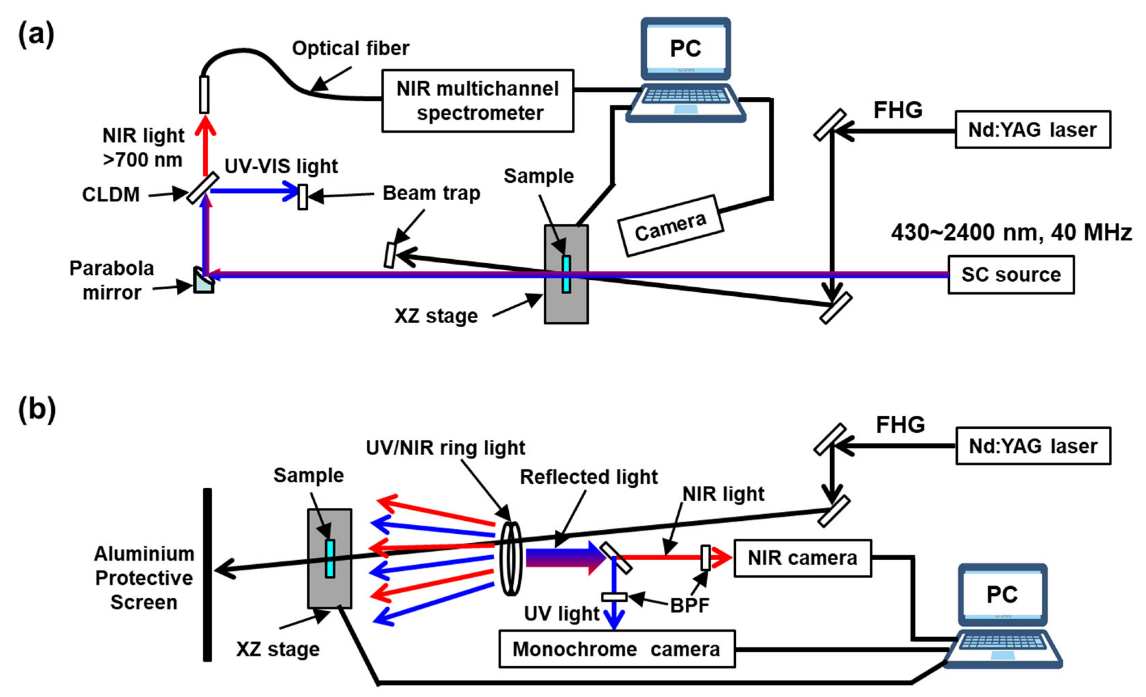
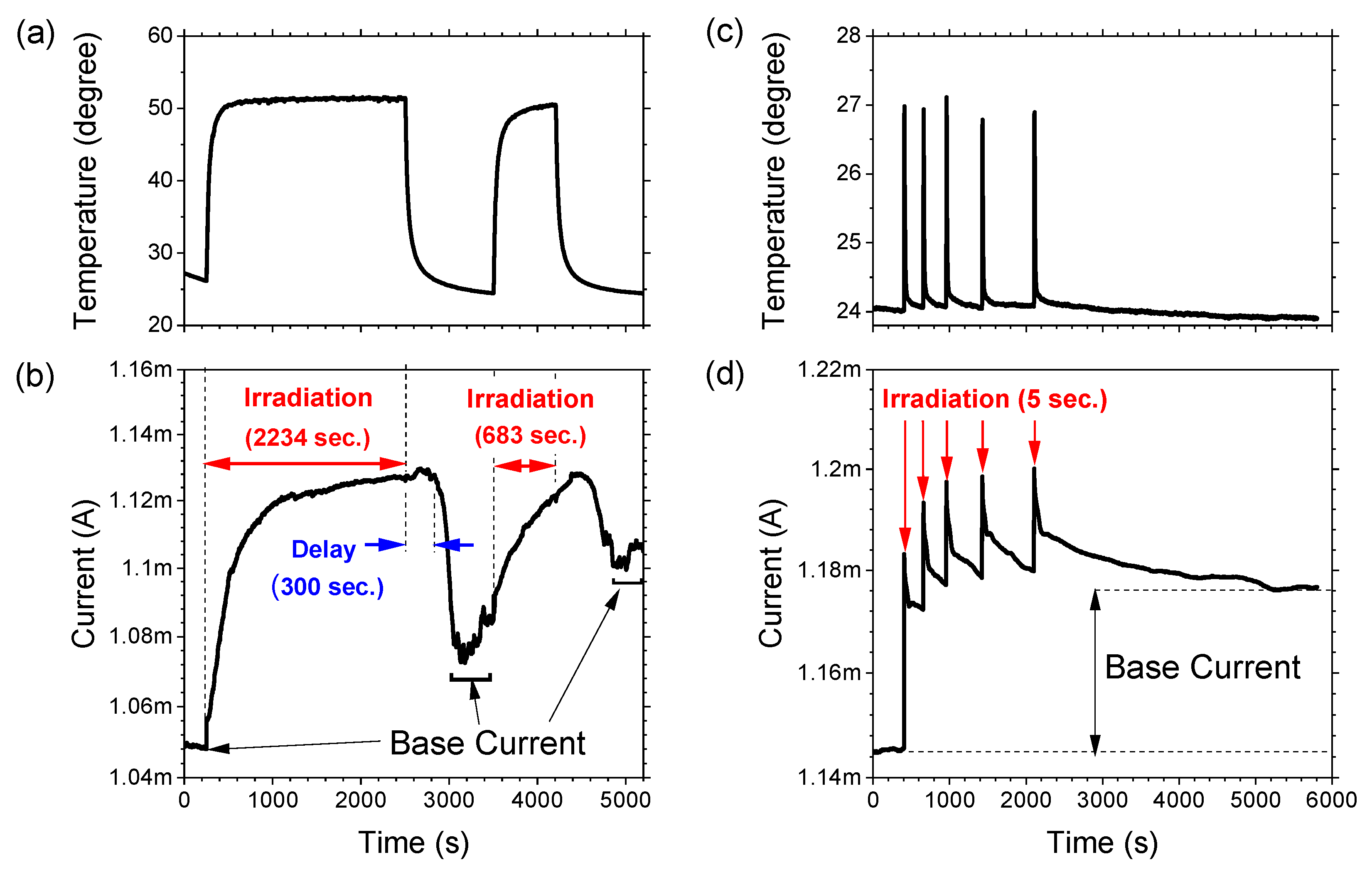
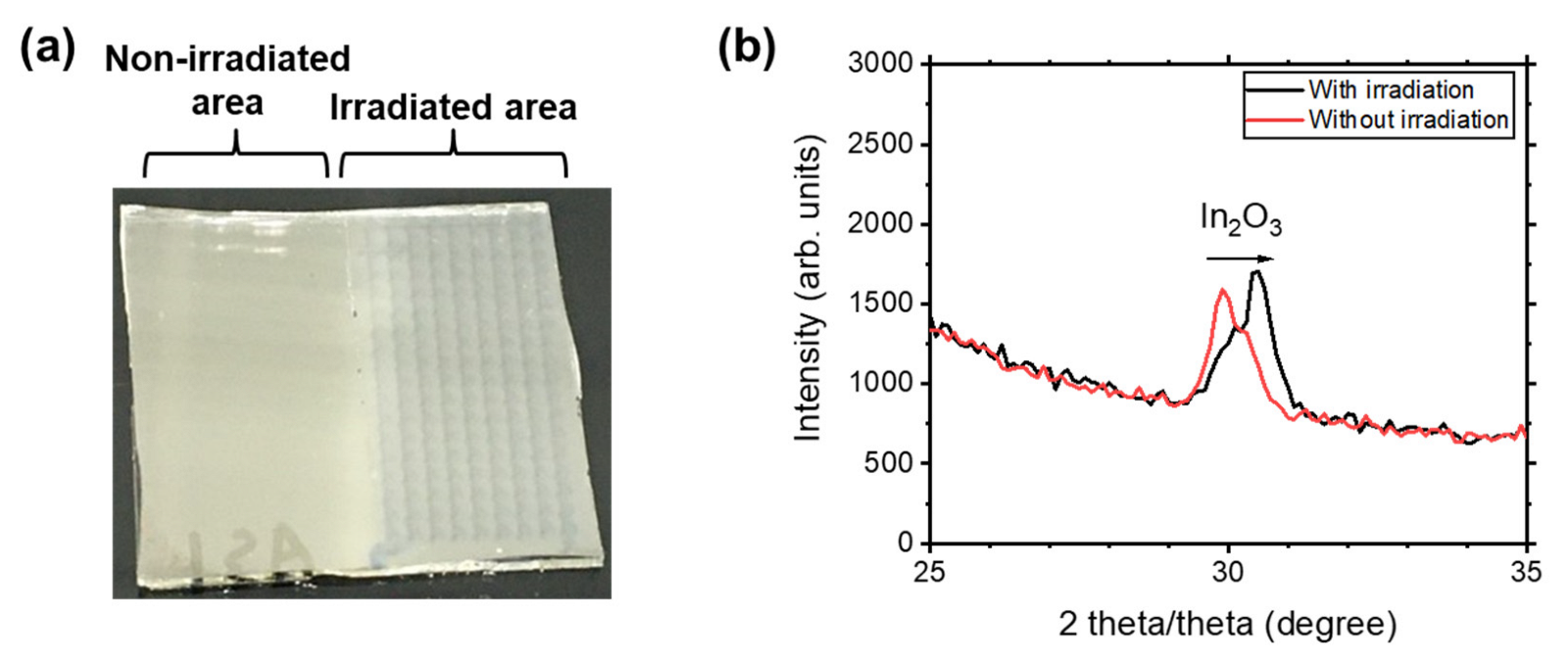

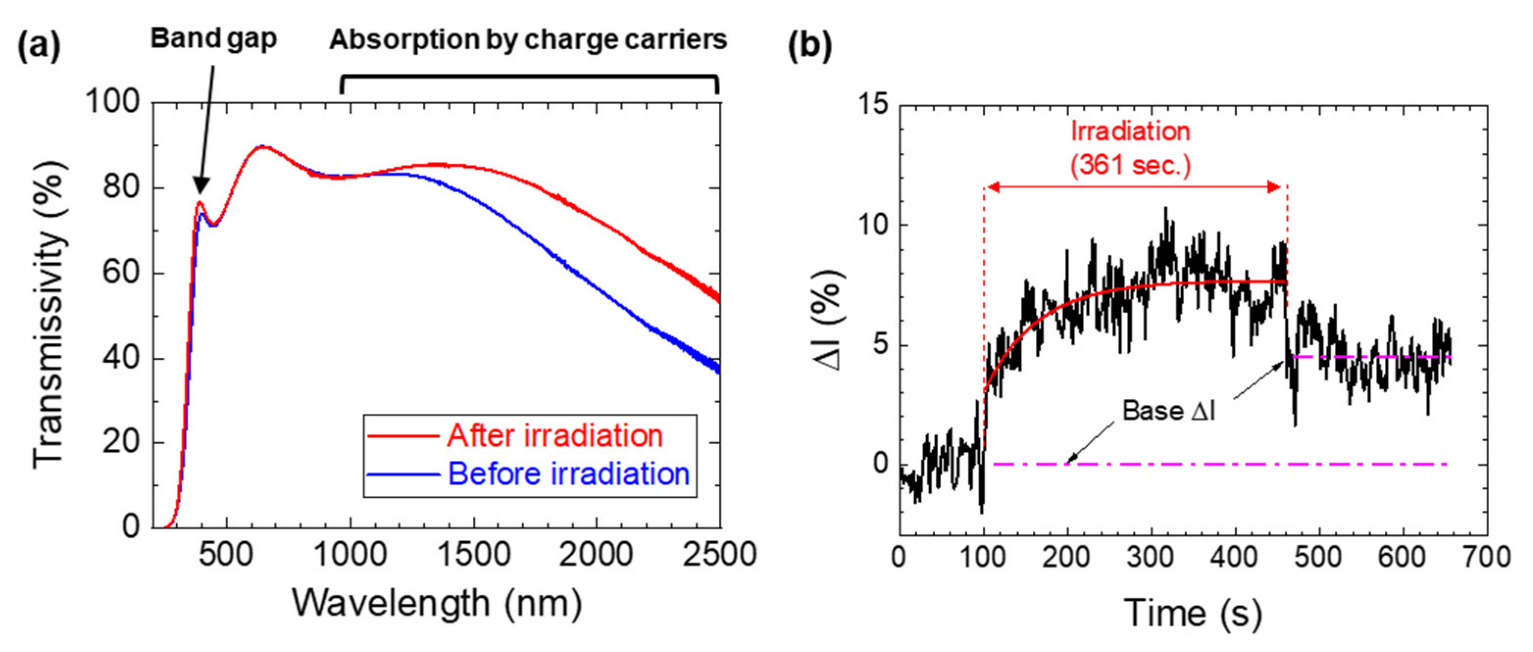
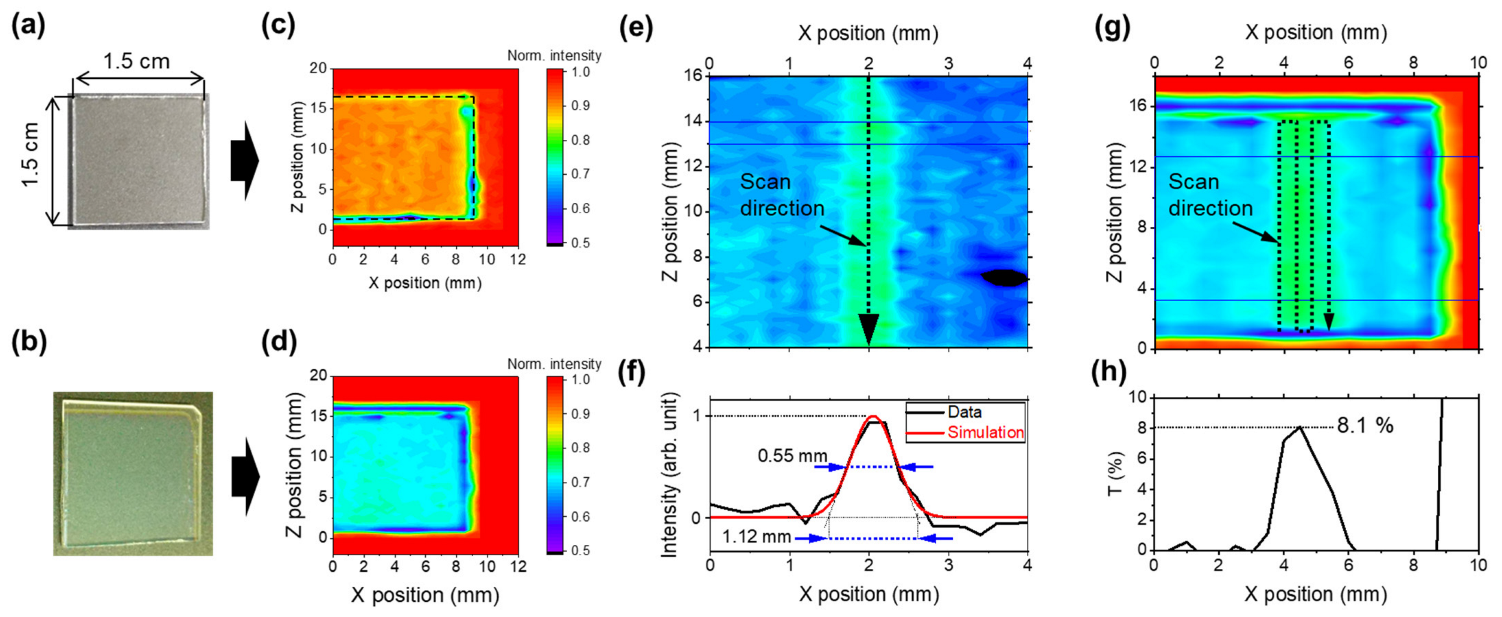


| Sample Area | Resistivity (Ωcm) | Carrier Concentration (cm−3) | Hall Mobility (cm2/V s) |
|---|---|---|---|
| Non-irradiated | 5.25 × 10−4 | 5.48 × 1020 | 21.3 |
| Irradiated | 2.73 × 10−4 | 1.09 × 1021 | 20.9 |
| Repetition Rate (Hz) | Resistance (Ω) | DT (°C) | |
|---|---|---|---|
| Before Irradiation | After Irradiation | ||
| 1 | 184 ± 10 | 167 ± 9 | Not detectable |
| 10 | 183 ± 14 | 168 ± 12 | ~0.1 ± 0.005 |
| 100 | 185 ± 16 | 163 ± 14 | 0.3 ± 0.028 |
| 1000 | 186 ± 6 | 166 ± 6 | 37.7 ± 0.005 |
Disclaimer/Publisher’s Note: The statements, opinions and data contained in all publications are solely those of the individual author(s) and contributor(s) and not of MDPI and/or the editor(s). MDPI and/or the editor(s) disclaim responsibility for any injury to people or property resulting from any ideas, methods, instructions or products referred to in the content. |
© 2023 by the authors. Licensee MDPI, Basel, Switzerland. This article is an open access article distributed under the terms and conditions of the Creative Commons Attribution (CC BY) license (https://creativecommons.org/licenses/by/4.0/).
Share and Cite
Hosokai, T.; Nomoto, J. The Real-Time Monitoring of the Laser-Induced Functionalization of Transparent Conductive Oxide Films. Nanomaterials 2023, 13, 2706. https://doi.org/10.3390/nano13192706
Hosokai T, Nomoto J. The Real-Time Monitoring of the Laser-Induced Functionalization of Transparent Conductive Oxide Films. Nanomaterials. 2023; 13(19):2706. https://doi.org/10.3390/nano13192706
Chicago/Turabian StyleHosokai, Takuya, and Junichi Nomoto. 2023. "The Real-Time Monitoring of the Laser-Induced Functionalization of Transparent Conductive Oxide Films" Nanomaterials 13, no. 19: 2706. https://doi.org/10.3390/nano13192706
APA StyleHosokai, T., & Nomoto, J. (2023). The Real-Time Monitoring of the Laser-Induced Functionalization of Transparent Conductive Oxide Films. Nanomaterials, 13(19), 2706. https://doi.org/10.3390/nano13192706






